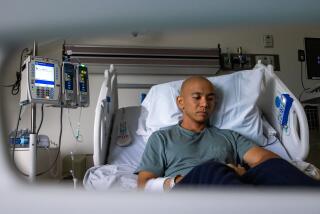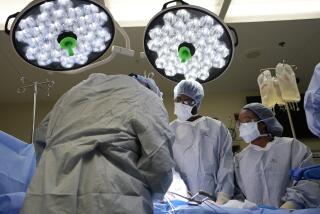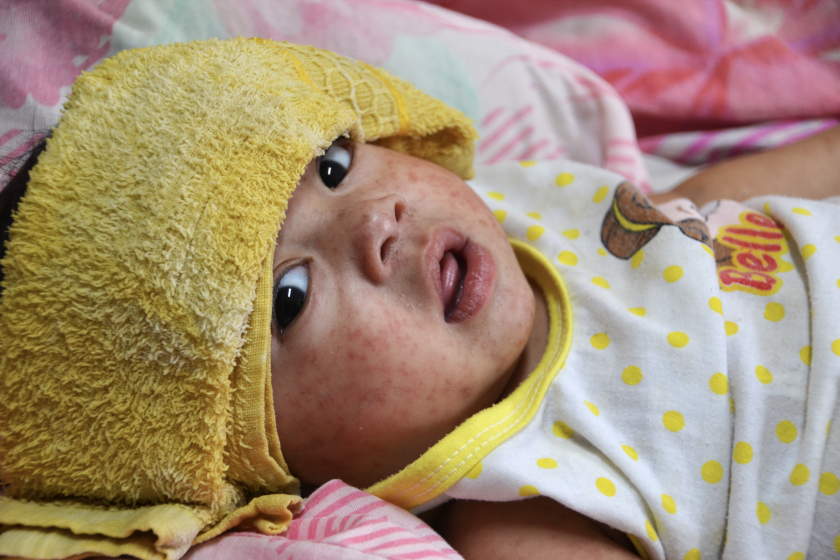A Bone Marrow Transplant Donor’s Sobering Brush With Death
- Share via
Giving the gift of life just about killed bone marrow donor Lina Joy.
In a rare complication to an increasingly common procedure, Joy, 44, of Paramount, contracted a staph infection in her marrow after the tissue was extracted from her pelvis at St. Joseph Hospital in Orange two years ago.
The ensuing treatment--including 65 days of hospitalization--brought her near death several times. She suffered liver, colon and kidney failure, and fell into a deep coma.
She is back working part time as the manager of a Bellflower dental office, but her health has been unalterably damaged. She has an immune disorder, a limp and a speech defect. She has constant back pain and unexplained rashes.
To add heartbreak to injury, the recipient of her marrow died before Joy left the hospital.
Further compounding her woes, Lina and her husband, Governor, 46, feared for months that more than $400,000 in unpaid medical bills would bankrupt them. Much of the financial fear was alleviated last month when the hospitals and doctors abruptly settled a medical malpractice suit the Joys had filed against them in 1997.
The case has become a watershed for the tight-knit marrow transplant community nationwide. Lina Joy’s near-death was the most serious complication for a donor in the 12-year history of the National Marrow Donor Program, doctors who run the program say.
Although the risk of serious complications remains low, the Joy case became a wake-up call for doctors who recruit donors.
Critics and supporters of the donor program agree that the Joys’ ordeal emphasizes the inexorable tension between the need to gather the lifesaving marrow and the obligation to ensure that donors recognize the real risks in even a simple surgery.
“If we were to minimize the risk, that wouldn’t be fair to donors who have complications,” said Dr. Peter Page, who heads the American Red Cross in Southern California, which runs programs for the national donor organization. “If we overemphasized the risks, that would hurt recipients.”
On any given day, 3,000 very sick people who have failed to find a donor among relatives are seeking a match among the 3.5 million people in the program’s Minneapolis registry, by far the largest of its kind in the country. All of them have cancer or other terminal illnesses.
Most people learn about giving marrow from the ubiquitous local drives that seek a match for a sick individual. Actually, the odds are infinitesimal that the sick person will match one of the volunteers, but it is an effective way to recruit donors for the bone marrow bank.
About 75% of transplants are for victims of leukemia or cancer of the marrow. But the demand for the procedure is growing as the technique has expanded to tackle hard tumor cancers, genetic disorders and some 40 other diseases.
For the recipient, transplantation is horrific and very risky. Patients are brought to the brink of death as their marrow is destroyed by massive radiation and chemotherapy. The donor’s marrow cells are then transfused into a vein and find their way to marrow sites, where hopefully they rebuild the immune system.
For the donor, the procedure is far simpler, commonly requiring at most one night in the hospital. About a quart of marrow is extracted from the pelvis, generally under general anesthesia.
Patients are told to expect sharp discomfort in the small of their back. The vast majority recover in several days, resuming full activity in two to three weeks. Complications are rare, and debilitating complications rarer still, said National Marrow Donor Program medical director Dr. Dennis Confer.
No donors in the program have died. Of the four known fatalities among bone marrow donors, three occurred overseas.
Volunteered in Hopes of Saving Local Boy
Marrow program literature intended for the public even today does not mention the fatalities or the Joy case, but everyone in the transplant community knows the story of Lina Joy.
“This was the most life-threatening case we have had,” Confer said.
Joy and her husband heard about marrow donation when their church held a drive for a local boy with leukemia. She wasn’t a match for him, but did fit a man in Australia.
Within a day of going home from St. Joseph Hospital on Dec. 11, 1996, where the harvesting was done in conjunction with Children’s Hospital of Orange County, the Joys realized there was a problem.
Joy had severe pain in her right hip and a high fever. She couldn’t move her right leg. She returned to St. Joseph with a staph infection that had taken root in her pelvis.
She would be hospitalized four more times--65 days over four months--and have surgery to repair bone destroyed by the infection. She was given massive doses of increasingly powerful antibiotics that had side effects of their own.
The recovery is slow. She sees doctors for chronic pain and the mysterious immune disorder. Along with the rashes, she has a permanent limp from the surgery and a slight speech impediment that appeared after the coma. She has little stamina and a lupus-like condition.
Transplant doctors walk a fine line between protecting donors and saving patients.
“There is a tension,” acknowledged Page of the Red Cross. “As physicians, we want to do no harm. But it would be a shame to overreact due to a single incident. There are many patients . . . who can only be saved through this.”
Critics contend that the program’s incremental recruitment process can lull donors and push them to participate. Typically, a person gives a little blood for genetic typing at a local drive, but doesn’t match that person. Only months later do donors learn that they are a potential lifeline for a stranger who found them through the National Marrow Donor Program registry.
Subsequently, they are invited to a counseling session where they are given more information and asked to sign an “intent to donate” consent form.
If they do, the process becomes hard to stop: The recipient will have his marrow destroyed in preparation for the transplant, and the donor must follow through or the recipient will die.
To a large degree, what donors learn about risk, even today, depends on what they hear at the counseling session.
“I feel the warnings on the donor forms are insufficient,” said one doctor who runs a major center. The doctor, who spoke on condition of anonymity, said he does the critical counseling--rather than leaving it to a nonphysician coordinator--and tries to err on the side of scaring a matched donor.
The two-page consent form signed by Lina Joy does discuss risk and includes this sentence: “Life-threatening reactions from bone marrow donation are extremely rare, however, the [National Marrow Donor Program] wants you to recognize that fatal complications during marrow donation could occur.”
Charles Wheldon, the Joys’ lawyer, called it “inadequate.”
For the Joys, part of the ordeal ended last month when they settled the lawsuit against the two hospitals and staff for an undisclosed sum and freedom from liability for unpaid bills. The case was settled just a week after the news that St. Joseph had discharged an infant with the wrong parents. The Joys say they hope that good will come from their ordeal.
They support calls for a good Samaritan law to limit donor liability for medical bills.
Lina Joy still finds “the blessings” in her experience and says she would encourage her adult children to be donors.
“I believe that life is a miracle and we don’t live for ourselves,” she said. “You cannot be a lone ranger. If you can help somebody by doing something as simple as giving a small piece of yourself, then you cannot deny a person their only chance at life.”






